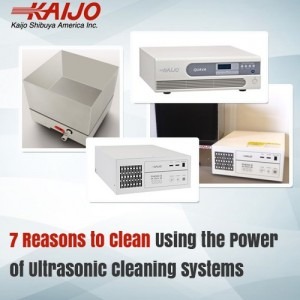7 Reasons to Clean Using the Power of Ultrasonic Cleaning Systems
November 16, 2016
 Ultrasonic cleaning systems can provide quick, efficient and effective cleaning of a variety of parts and equipment without the use of chemicals or mechanical action. As a result, companies that use these systems increase productivity and process throughput while reducing the use of consumables. Below are seven reasons for using ultrasonic cleaning systems and the details of why they are superior in each case.
Ultrasonic cleaning systems can provide quick, efficient and effective cleaning of a variety of parts and equipment without the use of chemicals or mechanical action. As a result, companies that use these systems increase productivity and process throughput while reducing the use of consumables. Below are seven reasons for using ultrasonic cleaning systems and the details of why they are superior in each case.
- Ultrasonic cleaning systems deliver improved cleaning performance.
Ultrasonic transducers generate microscopic bubbles whose collapse creates an intensive scrubbing action throughout the cleaning solution. The bubbles act around corners, in crevices and through holes to clean parts and equipment of all shapes and sizes. By adjusting the ultrasonic frequency and the power, the cleaning action of the bubbles can be adjusted in intensity to match the particular cleaning requirements. Contaminants and foreign material are removed quickly and completely.
- Parts and equipment are cleaned faster.
Cleaning with chemicals is slow as the parts and equipment to be cleaned have to soak in the cleaning solution that subsequently has to be neutralized. Additional mechanical scrubbing is often required and the times between batches are substantial because of the time required to change and set up the chemical baths. Ultrasonic cleaning uses only water and occasionally a mild solvent for even the most challenging cleaning tasks. Cleaning can take as little as a few minutes and rarely over two hours.
- Ultrasonic cleaning removes contaminants without damaging parts and equipment to be cleaned.
Cleaning processes that use blasting, scrubbing or harsh chemicals can cause damage such as pitting, scratching and bending in the material to be cleaned. Ultrasonic cleaning systems can adjust the frequency to deliver the cleaning intensity required. Lower frequencies have larger bubbles with more robust cleaning action while higher frequencies provide more gentle cleaning. The frequencies used can be fine tuned to remove dirt while leaving the underlying surfaces unaffected.
- Ultrasonic cleaning systems are environmentally friendly.
Unlike traditional cleaning methods that often use harsh chemicals to remove stubborn contamination, ultrasonic cleaning systems operate in water or in a solution containing mild solvents. Chemicals have to be stored, handled, mixed, used and neutralized. Even when treated they are not benign when discharged and accidents during storage, handling and use are always possible. These environmental threats and pollution do not exist with ultrasonic systems.
- Ultrasonic technology is safer for workers.
Many chemical cleaning processes use materials that are hazardous and cleaning techniques such as water blasting also have safety issues. Operator errors can put personnel at risk and accidents can have severe consequences. Ultrasonic technology is safe and has no hazardous components, materials or processes. Risk to personnel from errors or accidents is much lower than for conventional cleaning systems.
- Ultrasonic cleaners have a higher capacity than conventional systems.
Once installed and set up, ultrasonic cleaning tanks and containers can clean parts and equipment almost continuously without down time. Material to be cleaned can be placed in the cleaning tanks and ultrasonic cleaning can begin immediately. Cleaning is rapid and thorough. When the material is clean, it can be removed and the next batch of cleaning can be started. The cleaning process itself is faster and throughput is higher than with conventional cleaning systems.
- Ultrasonic systems are versatile and can handle a variety of applications.
Ultrasonic systems consist of ultrasonic generators, transducers and the cleaning tanks. Multiple high-powered transducers can be configured in very large tanks to handle the ultrasonic cleaning of large equipment. Low frequencies deliver robust cleaning for such applications. At the other end of the scale, single transducers can be mounted in small tanks to clean a variety of parts and high frequencies can be used to clean delicate components. Ultrasonic cleaning systems can provide the many different cleaning tasks required for industrial plants using heavy equipment.
Kaijo’s ultrasonic cleaning systems deliver cleaning performance that validates the above 7 reasons for using ultrasonic cleaning. The company can evaluate the cleaning needs of industrial customers including those need heavy equipment applications and deliver corresponding solutions. If you would like a free consultation or advice on using an ultrasonic cleaning system for your specific application call Kaijo or email info@kaijo-shibuya.com.





